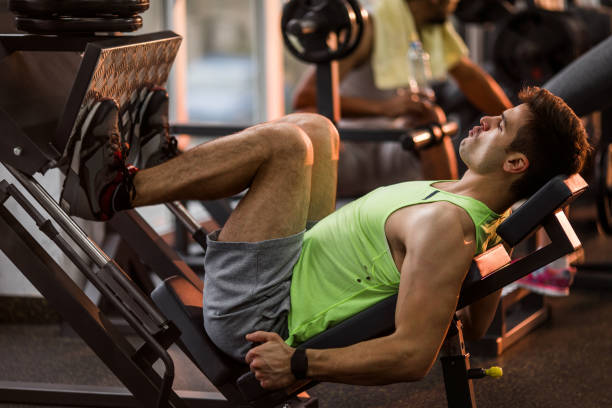Leg Press Machine Exercise | Ultimate Leg Press Workout Guide
Get the Most Out of the Leg Press Exercise
The leg press is a great lower body exercise that can help build muscle mass and strength in your quads, hamstrings and glutes. When performed properly, the leg press is a safe and effective way to work multiple muscle groups at once.
This guide will teach you everything you need to know to get the most out of the leg press machine, from proper form and foot placement to variations that target different muscles.
Let's get started!
What Muscles Does the Leg Press Work?
The leg press is a compound exercise, meaning it engages multiple muscle groups at once. The primary movers are:
- Quadriceps (front of thighs) - Your quads straighten your knee to lift and push the platform away from you. They get an intense workout during the leg press.
- Hamstrings (back of thighs) - Your hamstrings work to bend your knee and control the weight on the descent. They assist your quads.
- Glutes - Your glutes stabilize your pelvis and work with your quads and hamstrings to move your legs.
The leg press also engages your calves and core muscles for stabilization. It's a great exercise for building overall leg muscle and lower body strength.
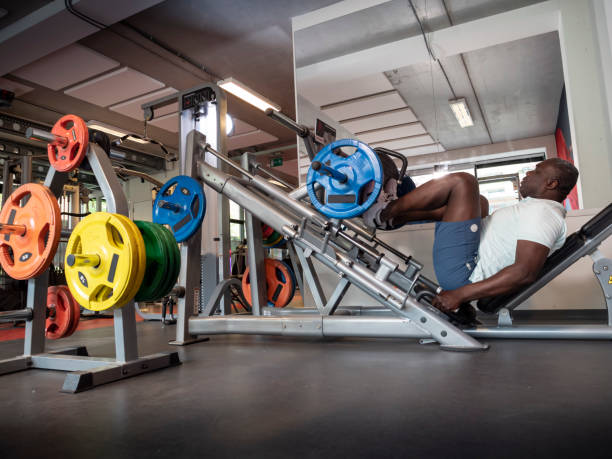
Benefits of the Leg Press
Some benefits of incorporating the leg press in your lower body workouts include:
- Builds quad, hamstring and glute strength
- Develops lower body muscle size ("leg gains")
- Safer alternative to heavy barbell squats
- Engages glutes more than squats for many people
- Allows higher weight due to machine assistance
- Little strain on lower back compared to squats
For these reasons, the leg press machine is a staple in most gym leg workouts and can complement squats well as part of a comprehensive lower body routine.
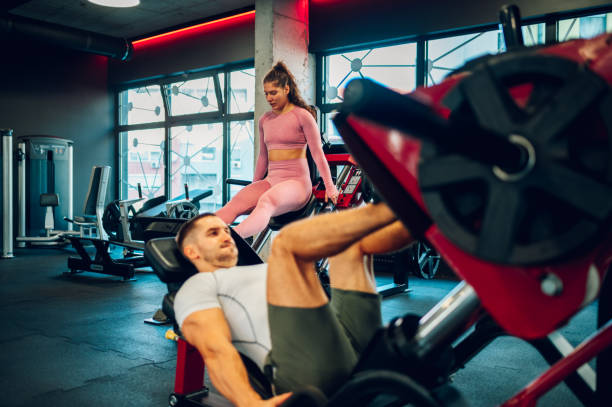
How to Use the Leg Press Machine: Proper Form
Using proper form on the leg press ensures you work the right muscles safely and effectively. Here are step-by-step instructions:
Step 1: Adjust the Machine
Set the height of the foot platform so your knees are bent at around 90 degrees when your legs are extended against the platform. Your knees should not be locked or bent too far.
Step 2: Sit Down and Place Your Feet
Sit on the machine with good upright posture, engaging your core. Place your feet flat on the platform about hip-width apart, toes pointing forward.
Step 3: Unlock the Safety Bars
Release the safety bars on either side and make sure you have full range of motion.
Step 4: Begin Exercise
Inhale, flex your quads, glutes and core, and press the platform away by straightening your legs until they reach near full extension without locking your knees.
Step 5: Control the Descent
Exhale, maintain core tightness, and slowly bend your knees to lower platform under control. Repeat.
Make sure to move smoothly without jerky motions, and don't let the weight drop rapidly even on last rep. Go at a weight that allows full control.
Leg Press Form Mistakes to Avoid
Improper leg press form can strain your lower back or knees. Common mistakes include:
- Locking knees at full extension
- Letting knees cave inward
- Lifting hips off seat during press
- Rounding lower back / arching back too far
- Bouncing weight or letting weights crash down
By using proper form, leg pressing should not hurt your knees or back. If you feel pain, lower the weight and focus on form.
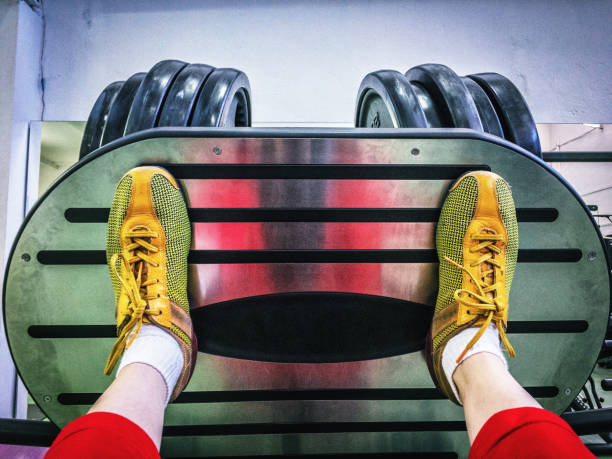
Standard Foot Placement vs Close and Wide Stance
There are three main foot positions on the leg press: standard, narrow (close) stance, and wide stance.
Standard Stance
Feet positioned about hip-width apart with toes facing forward is the standard leg press foot placement. This allows you to lift the most weight and works all the main movers - quads, hamstrings and glutes. It's a good overall starting point for most people.
Narrow Stance
Turning toes in and positioning feet closer together makes the exercise harder by increasing range of motion. This inward position better activates the inner thigh muscles. Your quads have to work extra to stabilize your knees. Use significantly less weight than standard stance.
Wide Stance
Rotating toes outward and widening foot position beyond shoulder width puts more focus on the outer quad muscles and glutes. Many people can press more weight this way. But don't go too wide as it also increases strain on the knees.
Experiment with different foot widths to find what feels best for your body. Wider and closer stances can help strengthen imbalances or weak points and provide variety.
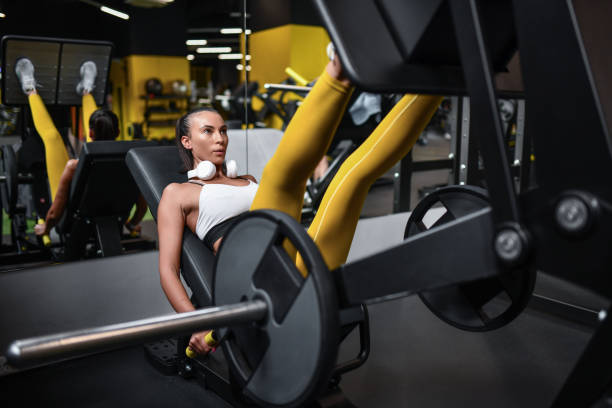
Leg Press Variations
Beyond foot placement, there are several leg press variations you can try:
Single-Leg Presses
Press one leg at a time to improve stability while preventing imbalances. Challenge your weaker side first then match reps with the stronger leg.
Heels Raised
Elevating heels on a plate or block targets the quads more. Keep lower back pressed into pad.
Toes Raised
Raising toes hits the hamstrings and glutes harder. You can use less weight than standard form.
There are also single leg heel or toe raised variations. Getting creative with new positions keeps muscles guessing.
How to Integrate Leg Presses into Your Workouts
Here are two examples of effective leg press workouts:
High Rep Burnout Finisher
After heavy squats, do very high rep (20-30) leg presses to fully fatigue quad and glute muscles. Lower weight as needed to hit rep target while maintaining form.
Leg Press-focused Leg Day
If you can't squat, build your workout around leg presses as the main lift. Perform 4 sets of 6-10 reps focusing on progressive overload and periodization principles over time. Complete with isolation movements like leg extensions or lunges.
The leg press can be used as a main lower body exercise, an assistance lift on leg day, or as a mechanical dropset to intensify your workout. Experiment to see what works best for you!
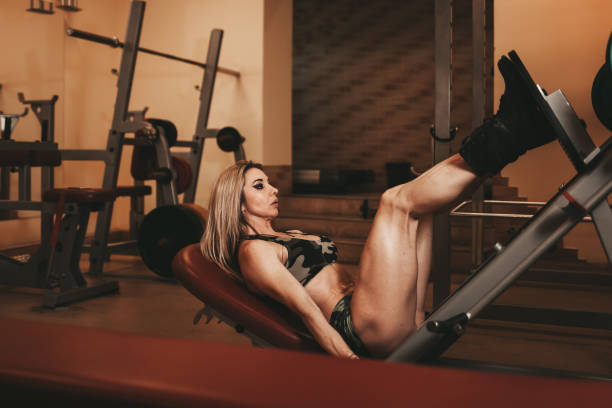
Wrap Up: Master the Leg Press
When performed properly, the leg press is one of the most effective compound lower body movements you can add to your training program. Work on gradually increasing weight in a controlled manner while maintaining proper form and position for best results. Periodically altering foot placement, stance width and using single leg can help strengthen imbalances.
What tips do you have for mastering the leg press machine? Which foot positions have you found most effective?
Let me know in the comments!
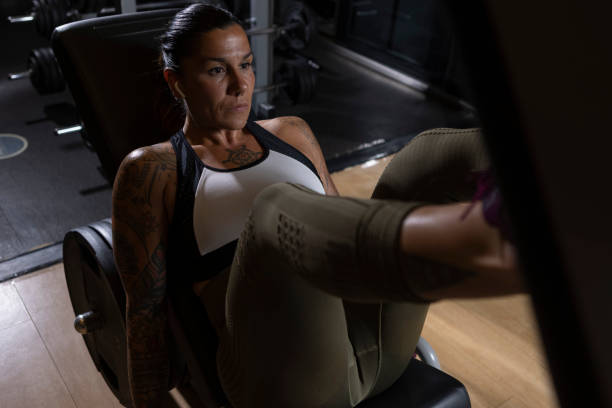
Frequently Asked Questions
What is the proper starting position on the leg press?
The starting position should have your knees bent at approximately 90 degrees, with your feet flat on the footplate about hip-width apart. Make sure your lower back is pressed into the pad and not arched.
Beginners should have a trainer handle the proper adjustments to ensure good spine alignment and reduce risk of injury.
Should I use my upper body when performing the leg press?
No, the leg press is an isolation exercise for your lower body. Keep your upper back pressed against the pad without lifting your shoulders. Don't push with your arms. Keep the movement focused in your leg muscles.
What muscles does the leg press work?
The leg press primarily works the major muscles in your lower body including the quadriceps, hamstrings and gluteal muscles. It offers great overall leg development compared to exercises like squats that can be harder on your back.
The leg press is a good substitute for squats if you experience knee pain.
Why is the leg press a great exercise option?
The leg press allows you to safely push your lower body using heavier weights than squats since the machine handles balance and stabilization.
You can really isolate and fatigue leg muscles with focused reps. It's great for building lower body strength.
Should I avoid lifting too much weight on the leg press?
Yes, avoid pushing your limits with extremely heavy weights, especially as a beginner. Poor form caused by heavy loads can momentarily tighten muscles unevenly, increasing injury risk.
Build up weight slowly keeping feet flat, spine aligned, and avoiding locked knees.
How do I performing the leg press with proper form?
Proper form requires keeping feet hip-width apart with toes forward. Push by straightening legs, squeezing glutes and quad muscles.
Control return by bending knees until calves touch thighs without letting weight crash down. Keep back flat and abdominal muscles tight.
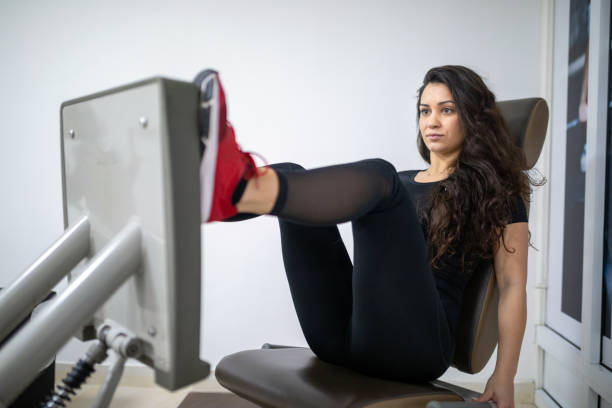
Proper Leg Press Technique: A Personal Trainer's Expert Advice
As a certified personal trainer with years of experience, I consider the leg press one of the most valuable exercises that use compound movement to build full lower body development. Properly performing this exercise effectively works all of the major muscles groups in your lower half from calves to quadriceps in one fluid motion.
The leg press is an ideal alternative to deadlifts or squats for individuals looking to isolate their leg and glute muscles without taxing other areas or skills like core stabilization required in free weights. The machine handles balancing the weights and adjusts to each exerciser, making it a great option for beginners too.
In my expert opinion, the success and safety of performing leg presses relies entirely on proper form. Here are the key technique points I coach all of my clients on:
- Always keep your lower back flattened and pressed into the pad. An arched back risks injury. Trainers can help handle adjustments to ensure your legs push away properly while torso and head remain still, never lifting from from the machine.
- When you place your feet, start hip-width apart with neutral foot positioning to engage all lower body muscle groups at once. Never start too narrow or wide which isolates specific muscles overworking them while failing to activate essential stabilizers. I see too many gym-goers with feet raised too high on the platform as well, which reduces range of motion missing key spots that build inner quad strength.
- As you push the platform away by straightening legs, consciously tighten your core to protect your spine and avoid overly recruiting hip flexors or lower back. The true effort must come from engaging your quads, hamstrings and glutes to move the weights. No cheating or throwing momentum from other areas!
Let me know if you have any other leg press questions - proper technique is key for both muscle development and injury prevention, so don't hesitate to ask a qualified trainer like myself. I'm always happy to help clients perform this exercise correctly.
For More Training Advice + Diet and Lifestyle visit us RIPL Fitness
PS: Make sure you check out the rest of our Legs Training Guides:
The Best Leg Strengthening Exercises for Seniors
8 Best Landmine Exercises | Landmine Leg & Lower Body Workout
Easy Wall Exercises For Legs | Wall Workout
8 Best Hack Squat Alternatives That Target Your Quads
10 Single Leg Exercises to Build Explosive Leg Strength
Best 10 TRX Leg Exercises For Lower Body | TRX Leg Workout
Best 18 Calisthenics Leg Exercises | Calisthenics Leg Workout
12 Best Kettlebell Leg Exercises | Leg Workout
9 Compound Leg Exercises | Best Compound Exercises For Lower Body

